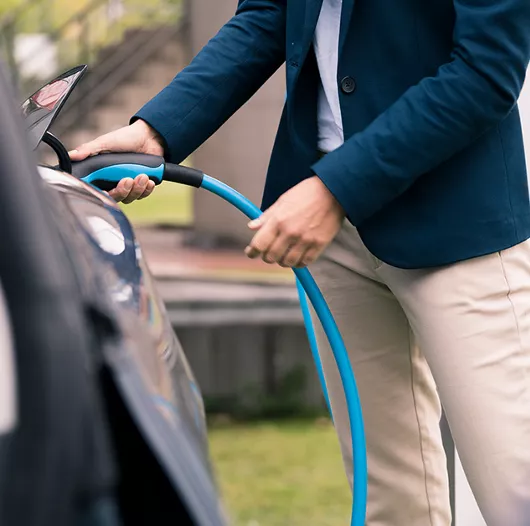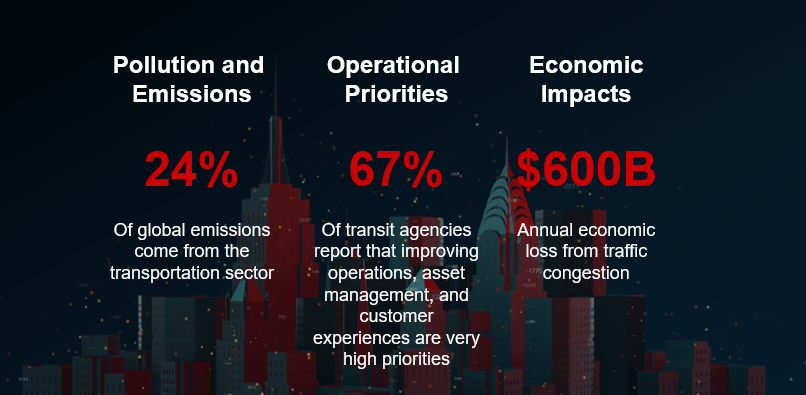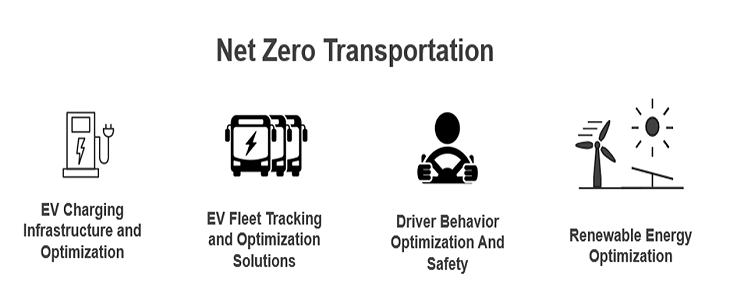Sustainability Won’t Get Very Far Without Transportation


Transportation now accounts for nearly one-fourth of all global emissions, posing a considerable challenge as governments and businesses look to promote greater sustainability in the battle to combat climate change.
Breaking this down further, 45% of transportation emissions come from passenger travel, 29% from road freight, with the remainder coming mostly from aviation and shipping along with a minor amount from rail and other. There's also an economic dimension to the urgency around improving transportation. Traffic congestion costs the world hundreds of billions in lost productivity, and transit is also a key resource to help people get themselves out of poverty.

Sources: Mass Transit Magazine survey with Hitachi Vantara, Economic Impact: https://www.cnbc.com/2019/12/24/traffic-jams-how-they-form-and-end-up-costing-the-us-economy-billions.html, Emissions: https://www.wri.org/blog/2019/10/everything-you-need-know-about-fastest-growing-source-global-emissions-transport
There is a way forward. But if we're going to usher in an era of sustainable transportation, we'll need to make a concerted push behind the following initiatives:
The most significant step for reaching sustainable transportation centers on the electrification of vehicles. This is a prodigious effort that will involve not only passenger cars, large fleets for logistics and freight, but also the modernization of the supporting energy chain. Renewable energy is spreading rapidly, but deploying it to power transportation kills two birds with one stone — reducing energy production emissions, while also enabling the adoption of electric vehicles (EVs).
Going to net zero for transportation requires building an EV charging infrastructure and making the EV ecosystem efficient. Reaching its full potential requires analytics and optimization. Data on vehicle traffic, large freight and fleet needs, and the availability of renewable energy sources are all vital aspects of this undertaking. Optimise Prime is a great example of a partnership of organizations — including Hitachi, Uber, and The Royal Mail — that are generating the world's largest EV charging and usage dataset to make electrified fleets more convenient and efficient.

Public transportation is a more efficient mode of transportation than one predicated on the ownership of personal automobiles, but it must be convenient, comfortable, and dependable if people are going to use it. One way that public transit systems can improve their efficiency is by implementing smart ticketing systems, which help people get through hubs faster, thereby protecting health and safety and optimizing schedules based on demand. This isn't a futuristic scenario. Smart spaces initiatives are already using technologies like 3D lidar and video analytics to analyze passenger flows, operations in metro stations, traffic on roads and parking lots, deriving insights to improve the safety, efficiency, and customer experience.
With analytics on the performance and condition of transportation fleets like buses and trains, organizations can optimize maintenance costs and anticipate scheduling and availability threats to improve reliability, ensuring more on-time, available transportation. Data can also help public trains and buses avoid accidents and slow-moving traffic.
For the last leg of multimodal transportation, micromobility (e-bikes, electric scooters, bicycles) can take people from transit hub to their destination. Micromobility reduces emissions and traffic from commuter vehicles, while increasing commuter capacity in congested urban spaces.
By now, it ought to be clear that a system based around fossil-fuel-powered automobiles trudging through traffic is energy inefficient. While the advent of electric vehicles and the infrastructure to support them constitute a major step in the right direction, improvements in traffic performance can also make a significant interim contribution to the goal of fostering greater sustainability. Using intersection monitoring and analytics, and analyzing parking and traffic patterns helps provide insights on improving the flow of traffic through urban spaces. Enabling drivers to get to parking spots faster through analytics on which spots are available reduces time spent circling for parking, which is estimated to be around 33% of city traffic.
As we return to the air for work and pleasure, smart airports are helping to reduce our carbon footprint. Some airlines have pledged to use more sustainable aviation fuel (SAF), while startups are experimenting with electric air taxis for short and medium range trips. In airports today, smart spaces are helping to provide insights on the use of the curbside, passenger wait times, and more, to improve efficiency. Some are also using lidar and video analytics to help make boarding smoother for passengers. One Hitachi project used 3D lidar to count and measure people's luggage as they boarded their planes, so the gate staff could predict when overhead space would run out and start putting the rest of the bags below the wing. This approach cut down delays and improved on-time performance, while reducing the number of airplanes idling on the taxiway or circling above waiting for their gates, and reducing fuel emissions in the process. These kinds of solutions, which improve both the passenger experience and foster sustainability, will be adopted widely in coming years.
The last and final step for sustainability in terms of transportation is a philosophical shift turned into action. We all know the mantra: reduce, reuse, and recycle. This applies to our vehicles and infrastructure as well. Using predictive and prescriptive maintenance, solutions like asset performance management help us to not only improve service, but also take better care of our vehicles, infrastructure, and other assets. The approach extends their life span and improves sustainability of our operations.
When we find ways to recycle or create downstream uses of the materials or assets, we help in creating a lasting circular economy — one that we can continue to enjoy and pass along to future generations.
Bjorn Andersson is Senior Director IoT Solutions Marketing at Hitachi Vantara.
Check out more great stories on Insights.

Bjorn has worked in technology development, product management and marketing for +25 years, with a focus on sustainability, digital transformation, analytics, visualization, HPC and IoT. Today, he provides strategic leadership for select industry practices at Hitachi Vantara.